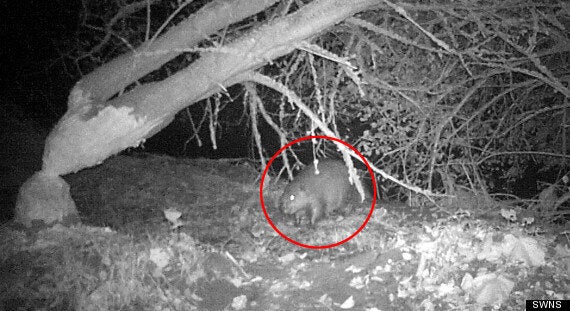Breaking cover under a cloak of darkness, what is believed to be Britain’s first wild beaver for half a century has been caught on camera for a second time.
The rare sight was captured as the mammal - native to North America - sank his teeth into a tree trunk.
Infrared recording equipment was set up specially after a string of sightings around Ottery St Mary, near Exeter in Devon.
Scroll down for more pictures

The beaver has been spotted around the River Otter near Exeter, Devon
Beavers were once native to Britain but were hunted to extinction during the reign of Henry VIII in the 16th century.
Conservationists have introduced several small groups back into captivity in the UK - but this is thought to be the first example of one found living in the wild.
Environmental scientist Tom Buckley used a camera which automatically takes photos when it picks up signs of movement and positioned it at several points around a small island owned by farmer David Lawrence.
Buckley had already seen evidence of bites and nibble marks on trees, so when he checked his camera some time later he was delighted to have caught the critter on film.

The beaver is believed to have been spotted once before in August
He said: "I first noticed a tree that had been damaged because I walk around that area every day - then I saw a few trees had been nibbled.
"For me it posed the question: could it have been a beaver, or was it some kids messing about? When I looked more closely it was clear the damage to the trees had been done by a beaver.
"What happens on David Lawrence's land near Ottery St Mary is that the river divides to leave a bit of an island in the middle and that's the main area where we are seeing the damage.
"It's where most of the trees have been laid down, not necessarily forming a dam, but it may be that this is the early stages."
It’s possible the beaver caught on Buckey’s cameras is the same one spotted last August by dog walker Lorna Douglas, 35.
She was able to observe and film it on her phone as it relaxed in the water 13 miles upstream on the same river.
Buckley says the evidence that it is a beaver is now irrefutable.
He added: "The only time I've seen the beaver in the flesh was around Christmas time when I saw its nose while it was in the water.
"Every time I've spotted it on the camera it's been in the pitch dark. It chews on trees and gathers branches together.
"Most of the sightings if not all have been when it comes out of the water and onto the land. The question now is if it's just one, or is it a pair.
"It may be one that's just passing through from somewhere else - it might be an escapee, but nobody seems to be saying they've lost a beaver."
Lawrence added: "We first saw signs last summer when a couple of trees came down - we thought it someone messing about with axes or something.
"We haven't seen the real animal yet, only the one in Buckley's photographs. But you can see the 'artwork' he does to the trees all around the area.
"It's early days yet but, as long as lots of people don't go there and frighten the beaver away, he should be happy enough.
"What's going to be really interesting is how it gets on with the other animals, like the otters which we see on the river."
The RSPCA says that the last few British beavers became extinct in Scotland during the 16th century.
During recent years they have been reintroduced in captive areas as part of breeding programs including at Ottery St Mary and Gloucestershire - but none are unaccounted for.
In Ottery St Mary the breeding pair built the first dam in Britain for 800 years and had two babies, known as “kits”.
During 2005 six beavers were also released into a 20-hectare enclosure in the Cotswolds, Gloustershire.
In October 2008 three escaped from their home in Lifton, Devon, but were all re-caught.
Beavers normally live in family groups and can survive up to 24 years in the wild and 35 years in captivity.
They are herbivorous rodents who build corridors in their dams to dodge predators such as wolves and bears in the wild.
The animals are nocturnal, grow to more than 3ft, weigh up to 70lbs, and feed on a diet of reeds, leaves and bark.
Beavers were hunted almost to extinction in Europe, both for fur and for castoreum, a secretion of its scent gland for medicinal properties.